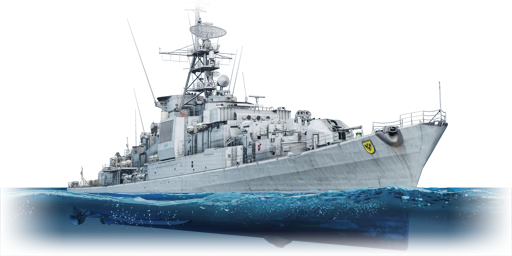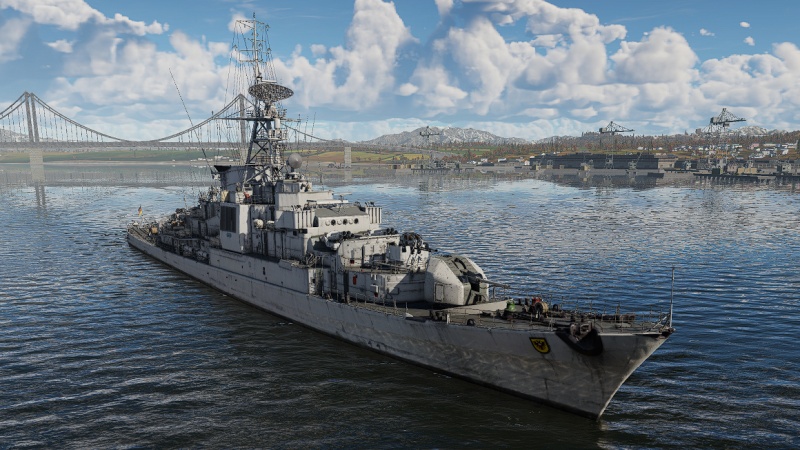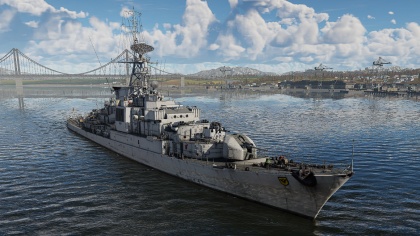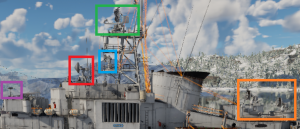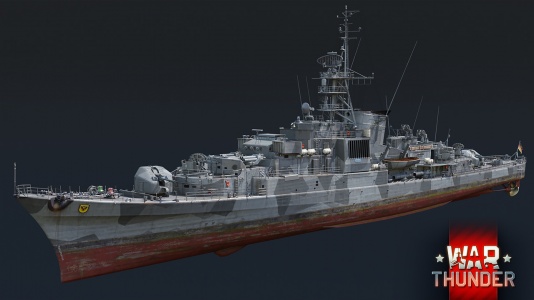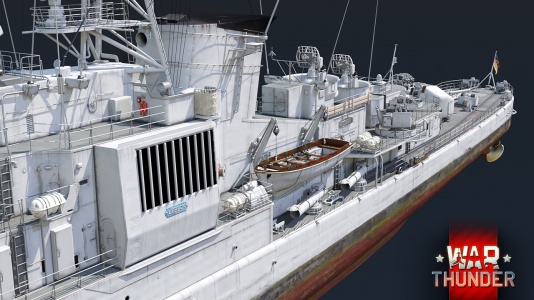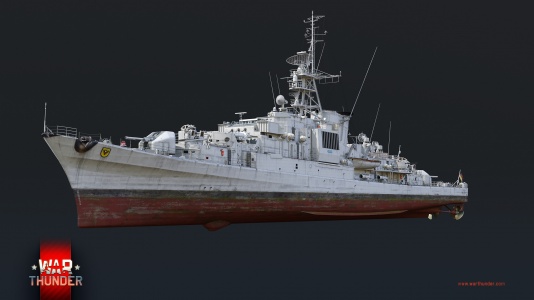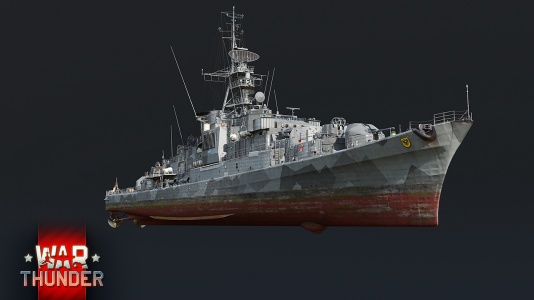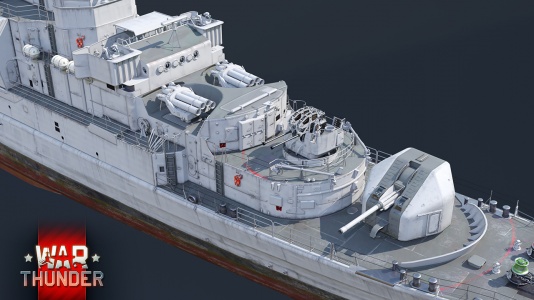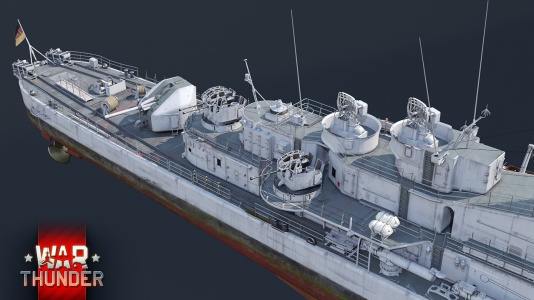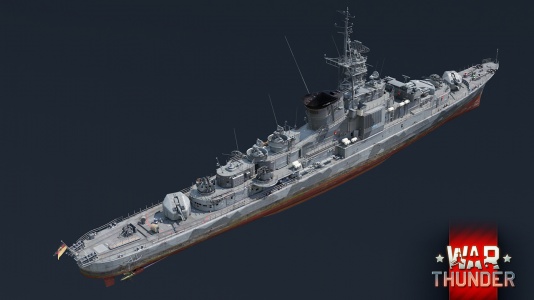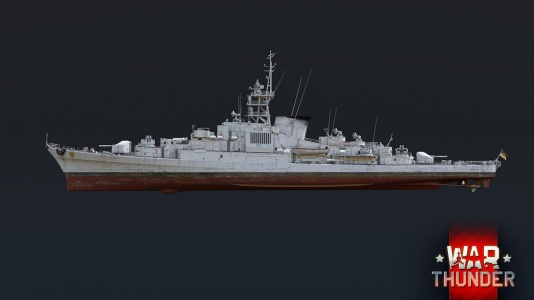Difference between revisions of "Lübeck"
(Added everything but the previous info, tables and such except radar table) (Tag: Visual edit) |
|||
| Line 14: | Line 14: | ||
{{Specs-Fleet-Armour}} | {{Specs-Fleet-Armour}} | ||
<!-- ''Talk about the vehicle's armour. Note the most well-defended and most vulnerable zones, e.g. the ammo magazine. Evaluate the composition of components and assemblies responsible for movement and manoeuvrability. Evaluate the survivability of the primary and secondary armaments separately. Don't forget to mention the size of the crew, which plays an important role in fleet mechanics. Save tips on preserving survivability for the "Usage in battles" section. If necessary, use a graphical template to show the most well-protected or most vulnerable points in the armour.'' --> | <!-- ''Talk about the vehicle's armour. Note the most well-defended and most vulnerable zones, e.g. the ammo magazine. Evaluate the composition of components and assemblies responsible for movement and manoeuvrability. Evaluate the survivability of the primary and secondary armaments separately. Don't forget to mention the size of the crew, which plays an important role in fleet mechanics. Save tips on preserving survivability for the "Usage in battles" section. If necessary, use a graphical template to show the most well-protected or most vulnerable points in the armour.'' --> | ||
| − | + | Overall, the survivabaility of the frigate is not comparable to cruisers or destroyers but is not lacklusture either. As a modern frigate, it lacks armor which are compensated by speed and firepower. Despite not being the most armed frigate in the game compared to vessels at the battle-rating, it is comparable to other Cold War vessels firepower wise and mobility wise, even comparable with early cruisers and destroyers. The number of crewmembers, despite being relatively high, are not sufficient if head-on engagements are planned, for this reason the frigate should not be used in the frontlines as it will be often destroyed with couple hits of enemy ships, specially those with high caliber weaponry. | |
| + | |||
| + | The armor is sufficient enough to stop low caliber munitions at some extent. While not invinsible, it is able to withstand even 105mm shells with decent amount of casualties and damage. Do not rely on the armor unless enemy threat has firepower lower than 76mm and even then, autocannons like the 40mm bofors mounted on USA and British ships will be able to cause critical damage if enough shots are fired. | ||
=== Mobility === | === Mobility === | ||
{{Specs-Fleet-Mobility}} | {{Specs-Fleet-Mobility}} | ||
<!-- ''Write about the ship's mobility. Evaluate its power and manoeuvrability, rudder rerouting speed, stopping speed at full tilt, with its maximum forward and reverse speed.'' --> | <!-- ''Write about the ship's mobility. Evaluate its power and manoeuvrability, rudder rerouting speed, stopping speed at full tilt, with its maximum forward and reverse speed.'' --> | ||
| − | + | Mobility wise, it is one of the fastest frigates/destroyers seen in game as for now despite the ship displacement and size. As a "modern" frigate, it changes completely the doctrine of previous destroyers and frigates, meaning it compenstates armour with speed. It is able to reach speeds above 40 knots (~75 km/h), making it terrifyingly fast for a ship of its size and firepower, almost on par with coastal fleet frigates and subchasers ([[Albatros-Klasse (143)]], [[Pr. 35]], etc). It is more than capable of reaching the battlefield faster than other destroyers and will outrun cruisers and battleships. When it comes to manoeuvrability, the F220 leaves nothing to expect. It is able to do tight turns (relatively tight turns but with greater speed than other frigates) as well as accelerate and decelerate quickly. Thanks to the relatively small size of the ship, it is able to stay on shallow waters compared to other frigates and destroyers which are prompt to stuck with rocks and any other obstacles. | |
{{NavalMobility}} | {{NavalMobility}} | ||
| Line 33: | Line 35: | ||
{{main|100 mm/55 MLE model 53 (100 mm)}} | {{main|100 mm/55 MLE model 53 (100 mm)}} | ||
| − | + | The F224 has the same armament as the [[Köln F220]], armed with 2 x 100 mm/55 MLE model 53 semi automatic cannons divided into 2 turrets, one at the aft and one at the bow. They are capable of decimating enemy vessels in seconds, including heavy cruisers. The 100 mm cannons have access to 2 types of shells, HE and HE-VT. Both shells have the exactly same performance with the exception of the proximity fuze the HE-VT gets. It is recommended to carry HE-VT as there are no cons of taking it compared to HE rather pros. HE-VT are an extra when it comes to air defence. They will decimate any enemy plane with an airbust but they are only recommended to be used when attacking low speed aircraft (like bombers) at long ranges (past 10 km) as the relative low fire rate (15 RPM) and targeting speed will cause issues engaging faster aircraft (fighters or even attackers). It should be noted the 100 mm can be used with the tracking radar the frigates has. | |
=== Secondary armament === | === Secondary armament === | ||
| Line 40: | Line 42: | ||
{{main|40 mm/70 MEL58 (40 mm)}} | {{main|40 mm/70 MEL58 (40 mm)}} | ||
| − | + | The F224 is armed with 6 x 40 mm/70 MEL58 automatic cannons divided into 2 dual-mounted turrets and 2 single-mount turrets. They are capable of shredding anything but cruisers. The 40 mm cannons only have access to HE and HE-VT, meaning they will do little to no damage to heavily armoured targets even at point blank range. The 40 mm are your main line of defence against light and medium armoured vessels as the fast firing rate (0.4 second reload) will cause fatal damage with even just one burst. They are also your main line of defence against any aircraft at any range from 0 to 10 km (AI gunners will not engage targets past ~10 km). They will destroy incoming enemy aircraft within seconds. The captain is able to control them manually and use the tracking radar to engage air targets manually. It is recommended to let the AI gunners engage the targets when the threat is closer than 5 km as the captain will be able to focus on more threatening enemies (other vessels or even aircraft). When letting AI gunners engage targets, be aware of which targeting setting is set (airborne and surface, airborne, surface, none) as each turret will only engage one target at a time. | |
=== Torpedo armament === | === Torpedo armament === | ||
| Line 46: | Line 48: | ||
{{main|12.75 inch Mark 44 (324 mm)}} | {{main|12.75 inch Mark 44 (324 mm)}} | ||
| − | + | The F220 is armed with 4 single-tube torpedo launchers. These are your main weapon against heavily armoured threats or when doing sneak attacks at distance. Different to the [[Köln F220]], the torpedo range changes drastically. They have a max range of 5.49km (not 13.71km) and can be used at almost point blank, the torpedo must travel 50 m at minimum to be armed (most of the time "point blank" engagements will be between 100-500 m). Depending on the map, game mode and captain's discretion, torpedo depth can be adjusted in order to achieve multiple tasks. | |
| + | |||
| + | '''''1 meter depth:''''' | ||
| + | |||
| + | This is the most universal depth used for all types of engagements, being in deep water or at shallow waters. This depth is capable of hitting all sorts of vessels, including PT boats. The main downside is that enemy ships can see the water trail made by the torpedo which can make enemy vessels evade or fire at the torpedo. | ||
| + | |||
| + | '''''4 meter depth:''''' | ||
| + | |||
| + | This is the recommended depth when on deep water trying to do long range sneaky engagements to big ships (most of them have bulkheads more than 4 m under the waterline). This is one of the riskier techniques as there is no way to launch them on shallow waters (most shallow water maps have water depth of 2-3 m). Only the captain and the team will be able to see the torpedo symbol while traveling close to them and it will not leave any visible water trail compared to the 1 meter depth torpedo. | ||
=== Special armament === | === Special armament === | ||
| Line 53: | Line 63: | ||
{{main|M/50 Bofors|Mk.6 depth charge}} | {{main|M/50 Bofors|Mk.6 depth charge}} | ||
| − | + | The F224 can be armed with Mk.6 depth charges. They are useless in all naval battles. It is not recommended to load them in the ship as they do not have any practical use in game. On the other hand, the Bofors rocket system has its advantages in various combat scenarios. First of all, said rockets have an explosive power of 107kg, almost the same explosive power 250kg bombs have. They are deadly agaisnt all light armored targets and can be used to take unarmed vessels (like in Naval Enduring Confrontation) or to create heavy exterior damage to enemy ships (disable turrets, destroy smoke funnels, destroy bridge, etc). Aiming this rockets requires practice as the low speed make the fire adjustment tricky. Always use rangefinder to aim vertically, do not attempt to use eye-trajectory as they will be inaccurate. | |
=== Additional armament === | === Additional armament === | ||
{{Specs-Fleet-Additional}} | {{Specs-Fleet-Additional}} | ||
| − | |||
| − | + | === Radar === | |
| + | [[File:F224 Radars.png|thumb|Purple: KH14/9 navigation radar | ||
| + | |||
| + | Red: M4/1Du FCR (currently not modeled as a functioning radar) | ||
| + | |||
| + | Blue: M5/1Du FCR (currently not modeled as a functioning radar) | ||
| + | |||
| + | Green: SGR105 air/surface search radar | ||
| + | |||
| + | Orange: M9/3Du FCR]] | ||
| + | While similar to the [[Köln F220]], the Lübeck F224 has a different radar configuration as well as types of radars. For game purposes, nothing changes. It has the SGR105 air/surface search radar, M4/1Du, M5/1Du, M9/3Du fire control radars (FCR) and access to the KH14/9 navigation radar, useless in its current state in game. The SGR105 is located on top of the main mast. The KH14/9 navigation radar is located on top of the bridge (replacing the MV2/3Du FCR). M4/1Du is located in front of the mast. M5/1Du is located in the mast below the SGR105 radar. M9/3Du are located at the back of the ship on top of the superestructure behind the main mast. Currently only the M9/3Du is the only one modeled as fire control radar in game. Enemy pilots are often unaware of the presence of the radar as they are uncommon in-game, use surprise to your advantage. Radars can give you a huge advantage with situational awareness as no plane will be able to catch you unsuspected. Be aware of radar interference (mountains, trees, tall structures in general) as they will affect both your search and tracking radar. There are blind spots with the radars which pilots can exploit but most of them will not do so as radars are uncommon in battles. As previously stated, tracking radar can be used to manually engage targets. It is recommended to use tracking radar when engaging immediate threats the gunners are not engaging or low speed flying aircraft at long ranges (bombers). Most of the time, the use of tracking radar will not be necessary as gunners will take care of aircraft while the captain is engaging enemy vessels. | ||
| + | {| class="wikitable" | ||
| + | ! colspan="4" |SGR105 - Air/surface Search Radar | ||
| + | |- | ||
| + | !Maximum | ||
| + | Detection Range | ||
| + | !Guaranteed | ||
| + | Detection Range | ||
| + | !Max Azimuth | ||
| + | Scan Angle | ||
| + | !Max Elevation | ||
| + | Scan Angle | ||
| + | |- | ||
| + | |120,000 m | ||
| + | |10,000 m | ||
| + | |360° | ||
| + | |0°/+85° | ||
| + | |- | ||
| + | ! colspan="4" |M9/3Du - Fire Control Radar | ||
| + | |- | ||
| + | !Maximum | ||
| + | Tracking Range | ||
| + | !Minimum | ||
| + | Tracking Range | ||
| + | !Azimuth Tracking | ||
| + | Angle | ||
| + | !Elevation Tracking | ||
| + | Angle | ||
| + | |- | ||
| + | |15,000 m | ||
| + | |100 m | ||
| + | |180°± | ||
| + | |0°/+80° | ||
| + | |} | ||
== Usage in battles == | == Usage in battles == | ||
Revision as of 01:06, 11 January 2021
Contents
Description
The Köln-class, Lübeck (F224) is a premium gift rank IV German frigate
with a battle rating of 4.3 (AB/RB/SB). It was introduced in Update "Raining Fire" as a reward for the 2020 Wargame "Strategist" event.
General info
Survivability and armour
Overall, the survivabaility of the frigate is not comparable to cruisers or destroyers but is not lacklusture either. As a modern frigate, it lacks armor which are compensated by speed and firepower. Despite not being the most armed frigate in the game compared to vessels at the battle-rating, it is comparable to other Cold War vessels firepower wise and mobility wise, even comparable with early cruisers and destroyers. The number of crewmembers, despite being relatively high, are not sufficient if head-on engagements are planned, for this reason the frigate should not be used in the frontlines as it will be often destroyed with couple hits of enemy ships, specially those with high caliber weaponry.
The armor is sufficient enough to stop low caliber munitions at some extent. While not invinsible, it is able to withstand even 105mm shells with decent amount of casualties and damage. Do not rely on the armor unless enemy threat has firepower lower than 76mm and even then, autocannons like the 40mm bofors mounted on USA and British ships will be able to cause critical damage if enough shots are fired.
Mobility
Mobility wise, it is one of the fastest frigates/destroyers seen in game as for now despite the ship displacement and size. As a "modern" frigate, it changes completely the doctrine of previous destroyers and frigates, meaning it compenstates armour with speed. It is able to reach speeds above 40 knots (~75 km/h), making it terrifyingly fast for a ship of its size and firepower, almost on par with coastal fleet frigates and subchasers (Albatros-Klasse (143), Pr. 35, etc). It is more than capable of reaching the battlefield faster than other destroyers and will outrun cruisers and battleships. When it comes to manoeuvrability, the F220 leaves nothing to expect. It is able to do tight turns (relatively tight turns but with greater speed than other frigates) as well as accelerate and decelerate quickly. Thanks to the relatively small size of the ship, it is able to stay on shallow waters compared to other frigates and destroyers which are prompt to stuck with rocks and any other obstacles.
| Mobility Characteristics | |||
|---|---|---|---|
| Game Mode | Upgrade Status | Maximum Speed (km/h) | |
| Forward | Reverse | ||
| AB | |||
| Upgraded | 83 | 35 | |
| RB/SB | |||
| Upgraded | 59 | 25 | |
Modifications and economy
Armament
Primary armament
The F224 has the same armament as the Köln F220, armed with 2 x 100 mm/55 MLE model 53 semi automatic cannons divided into 2 turrets, one at the aft and one at the bow. They are capable of decimating enemy vessels in seconds, including heavy cruisers. The 100 mm cannons have access to 2 types of shells, HE and HE-VT. Both shells have the exactly same performance with the exception of the proximity fuze the HE-VT gets. It is recommended to carry HE-VT as there are no cons of taking it compared to HE rather pros. HE-VT are an extra when it comes to air defence. They will decimate any enemy plane with an airbust but they are only recommended to be used when attacking low speed aircraft (like bombers) at long ranges (past 10 km) as the relative low fire rate (15 RPM) and targeting speed will cause issues engaging faster aircraft (fighters or even attackers). It should be noted the 100 mm can be used with the tracking radar the frigates has.
Secondary armament
The F224 is armed with 6 x 40 mm/70 MEL58 automatic cannons divided into 2 dual-mounted turrets and 2 single-mount turrets. They are capable of shredding anything but cruisers. The 40 mm cannons only have access to HE and HE-VT, meaning they will do little to no damage to heavily armoured targets even at point blank range. The 40 mm are your main line of defence against light and medium armoured vessels as the fast firing rate (0.4 second reload) will cause fatal damage with even just one burst. They are also your main line of defence against any aircraft at any range from 0 to 10 km (AI gunners will not engage targets past ~10 km). They will destroy incoming enemy aircraft within seconds. The captain is able to control them manually and use the tracking radar to engage air targets manually. It is recommended to let the AI gunners engage the targets when the threat is closer than 5 km as the captain will be able to focus on more threatening enemies (other vessels or even aircraft). When letting AI gunners engage targets, be aware of which targeting setting is set (airborne and surface, airborne, surface, none) as each turret will only engage one target at a time.
Torpedo armament
The F220 is armed with 4 single-tube torpedo launchers. These are your main weapon against heavily armoured threats or when doing sneak attacks at distance. Different to the Köln F220, the torpedo range changes drastically. They have a max range of 5.49km (not 13.71km) and can be used at almost point blank, the torpedo must travel 50 m at minimum to be armed (most of the time "point blank" engagements will be between 100-500 m). Depending on the map, game mode and captain's discretion, torpedo depth can be adjusted in order to achieve multiple tasks.
1 meter depth:
This is the most universal depth used for all types of engagements, being in deep water or at shallow waters. This depth is capable of hitting all sorts of vessels, including PT boats. The main downside is that enemy ships can see the water trail made by the torpedo which can make enemy vessels evade or fire at the torpedo.
4 meter depth:
This is the recommended depth when on deep water trying to do long range sneaky engagements to big ships (most of them have bulkheads more than 4 m under the waterline). This is one of the riskier techniques as there is no way to launch them on shallow waters (most shallow water maps have water depth of 2-3 m). Only the captain and the team will be able to see the torpedo symbol while traveling close to them and it will not leave any visible water trail compared to the 1 meter depth torpedo.
Special armament
The F224 can be armed with Mk.6 depth charges. They are useless in all naval battles. It is not recommended to load them in the ship as they do not have any practical use in game. On the other hand, the Bofors rocket system has its advantages in various combat scenarios. First of all, said rockets have an explosive power of 107kg, almost the same explosive power 250kg bombs have. They are deadly agaisnt all light armored targets and can be used to take unarmed vessels (like in Naval Enduring Confrontation) or to create heavy exterior damage to enemy ships (disable turrets, destroy smoke funnels, destroy bridge, etc). Aiming this rockets requires practice as the low speed make the fire adjustment tricky. Always use rangefinder to aim vertically, do not attempt to use eye-trajectory as they will be inaccurate.
Additional armament
Radar
While similar to the Köln F220, the Lübeck F224 has a different radar configuration as well as types of radars. For game purposes, nothing changes. It has the SGR105 air/surface search radar, M4/1Du, M5/1Du, M9/3Du fire control radars (FCR) and access to the KH14/9 navigation radar, useless in its current state in game. The SGR105 is located on top of the main mast. The KH14/9 navigation radar is located on top of the bridge (replacing the MV2/3Du FCR). M4/1Du is located in front of the mast. M5/1Du is located in the mast below the SGR105 radar. M9/3Du are located at the back of the ship on top of the superestructure behind the main mast. Currently only the M9/3Du is the only one modeled as fire control radar in game. Enemy pilots are often unaware of the presence of the radar as they are uncommon in-game, use surprise to your advantage. Radars can give you a huge advantage with situational awareness as no plane will be able to catch you unsuspected. Be aware of radar interference (mountains, trees, tall structures in general) as they will affect both your search and tracking radar. There are blind spots with the radars which pilots can exploit but most of them will not do so as radars are uncommon in battles. As previously stated, tracking radar can be used to manually engage targets. It is recommended to use tracking radar when engaging immediate threats the gunners are not engaging or low speed flying aircraft at long ranges (bombers). Most of the time, the use of tracking radar will not be necessary as gunners will take care of aircraft while the captain is engaging enemy vessels.
| SGR105 - Air/surface Search Radar | |||
|---|---|---|---|
| Maximum
Detection Range |
Guaranteed
Detection Range |
Max Azimuth
Scan Angle |
Max Elevation
Scan Angle |
| 120,000 m | 10,000 m | 360° | 0°/+85° |
| M9/3Du - Fire Control Radar | |||
| Maximum
Tracking Range |
Minimum
Tracking Range |
Azimuth Tracking
Angle |
Elevation Tracking
Angle |
| 15,000 m | 100 m | 180°± | 0°/+80° |
Usage in battles
Describe the technique of using this ship, the characteristics of her use in a team and tips on strategy. Abstain from writing an entire guide – don't try to provide a single point of view, but give the reader food for thought. Talk about the most dangerous opponents for this vehicle and provide recommendations on fighting them. If necessary, note the specifics of playing with this vehicle in various modes (AB, RB, SB).
Modules
| Tier | Seakeeping | Unsinkability | Firepower | |||
|---|---|---|---|---|---|---|
| I | Dry-Docking | Tool Set | ||||
| II | Rudder Replacement | Fire Protection System | Smokescreen | Auxiliary Armament Targeting | ||
| III | Propeller Replacement | Shrapnel Protection | Ventilation | Improved Rangefinder | Primary Armament Targeting | Depth Charges |
| IV | Engine Maintenance | New Pumps | Ammo Wetting | 100 mm OPF F4 PFHE | 40 mm HE-T-PF | Rocket Launcher |
| This is a premium vehicle: all modifications are unlocked on purchase | ||||||
Pros and cons
Summarise and briefly evaluate the vehicle in terms of its characteristics and combat effectiveness. Mark its pros and cons in the bulleted list. Try not to use more than 6 points for each of the characteristics. Avoid using categorical definitions such as "bad", "good" and the like - use substitutions with softer forms such as "inadequate" and "effective".
Pros:
Cons:
History
Lübeck was one of six Köln-class frigates constructed by the Blohm & Voss company and represented one of the first warships built for the German navy in the years following WWII. Lübeck and her sister ships were designed to counter enemy escort ships as well as submarines and were well-equipped to perform these tasks.
Lübeck was commissioned in June of 1963 as the fifth Köln-class frigate to enter service. The ship continued service until December 1988 after she was decommissioned and sold to Turkey for scrapping.
- From Devblog
Media
- Lübeck Devblog Images
See also
Links to articles on the War Thunder Wiki that you think will be useful for the reader, for example:
- reference to the series of the ship;
- links to approximate analogues of other nations and research trees.
External links
| Germany frigates | |
|---|---|
| |
Kriegsmarine |
| K-class | K2 |
| |
Bundesmarine |
| Köln-class | Köln · Lübeck |
| |
Volksmarine |
| Pr. 50 | Karl Marx |
| Germany premium ships | |
|---|---|
| Motor torpedo boats | LS 4 Esau · KM-5 · S-204 Lang · S-701 |
| Minelayers | VS-8 |
| Sub-chasers | M-802 |
| Frigates | Lübeck |
| Destroyers | Jaguar · Luchs · T31 · Z20 Karl Galster · Z25 · Z47 |
| Light cruisers | Karlsruhe |
| Heavy cruisers | Prinz Eugen |
| Battleships | SMS Nassau |


